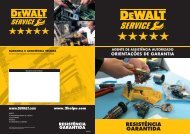Î¦Ï Î»Î»Î¬Î´Î¹Î¿ οδηγιÏν
Î¦Ï Î»Î»Î¬Î´Î¹Î¿ οδηγιÏν
Î¦Ï Î»Î»Î¬Î´Î¹Î¿ οδηγιÏν
You also want an ePaper? Increase the reach of your titles
YUMPU automatically turns print PDFs into web optimized ePapers that Google loves.
ENGLISHBe sure saw is up to full speed before blade contactsmaterial to be cut. Starting saw with blade againstmaterial to be cut or pushed forward into kerf canresult in kickback. Push the saw forward at a speedwhich allows the blade to cut without laboring.Hardness and toughness can vary even in the samepiece of material, and knotty or damp sections canput a heavy load on the saw. When this happens,push the saw more slowly, but hard enough to keepworking without much decrease in speed. Forcingthe saw can cause rough cuts, inaccuracy, kickback,and over-heating of the motor. Should your cutbegin to go off the line, don’t try to force it backon. Release the switch and allow blade to come toa complete stop. Then you can withdraw the saw,sight anew, and start a new cut slightly inside thewrong one. In any event, withdraw the saw if youmust shift the cut. Forcing a correction inside the cutcan stall the saw and lead to kickback.IF SAW STALLS, RELEASE THE TRIGGER ANDBACK THE SAW UNTIL IT IS LOOSE. BE SUREBLADE IS STRAIGHT IN THE CUT AND CLEAR OFTHE CUTTING EDGE BEFORE RESTARTING.As you finish a cut, release the trigger and allow theblade to stop before lifting the saw from the work.As you lift the saw, the spring-tensioned telescopingguard will automatically close under the blade.Remember the blade is exposed until this occurs.Never reach under the work for any reason. Whenyou have to retract the telescoping guard manually(as is necessary for starting pocket cuts) always usethe retracting lever.NOTE: When cutting thin strips, be careful to ensurethat small cutoff pieces don’t hang up on inside oflower guard.RIPPINGRipping is the process of cutting wider boards intonarrower strips – cutting grain lengthwise. Handguiding is more difficult for this type of sawing andthe use of a DEWALT parallel fence (fig. 11, w) isrecommended.POCKET CUTTING (FIG. 18)WARNING: Never tie the blade guard ina raised position. Never move the sawbackwards when pocket cutting. Thismay cause the unit to raise up off thework surface which could cause injury.A pocket cut is one that is made in a floor, wall orother flat surface.1. Adjust the saw foot plate so the blade cuts atdesired depth.2. Tilt the saw forward and rest front of the footplate on material to be cut.3. Using the lower guard lever, retract lower bladeguard to an upward position. Lower rear of footplate until blade teeth almost touch cutting line.4. Release the blade guard (its contact with thework will keep it in position to open freely as youstart the cut). Remove hand from guard leverand firmly grip auxiliary handle (e), as shown inFigure 18. Position your body and arm to allowyou to resist kickback if it occurs.5. Make sure blade is not in contact with cuttingsurface before starting saw.6. Start the motor and gradually lower the sawuntil its foot plate rests flat on the material to becut. Advance saw along the cutting line until cutis completed.7. Release trigger and allow blade to stopcompletely before withdrawing the blade fromthe material.8. When starting each new cut, repeat as above.Dust Extraction (fig. 19)WARNING: Risk of dust inhalation.To reduce the risk of personal injury,ALWAYS wear an approved dust mask.A dust extraction spout (y) is supplied with your tool.Vacuum hoses of most common vacuum extractorswill fit directly into the dust extraction spout.WARNING: ALWAYS use a vacuumextractor designed in compliance withthe applicable directives regarding dustemission when sawing wood. Vacuumhoses of most common vacuumcleaners will fit directly into the dustextraction outlet.AIRLOCK CONNECTOR SYSTEM - DWV9000(SOLD SEPARATELY) (FIG. 19)AirLock allows for a fast and secure connectionbetween the tool's dust extraction spout (y) and thedust extractor.1. Ensure the collar on the AirLock connector isin the unlock position. Align notches on collarand AirLock connector as shown for unlock andlock positions.2. Push the AirLock connector onto the dustextraction spout (y).3. Rotate the collar to the locked position.40







